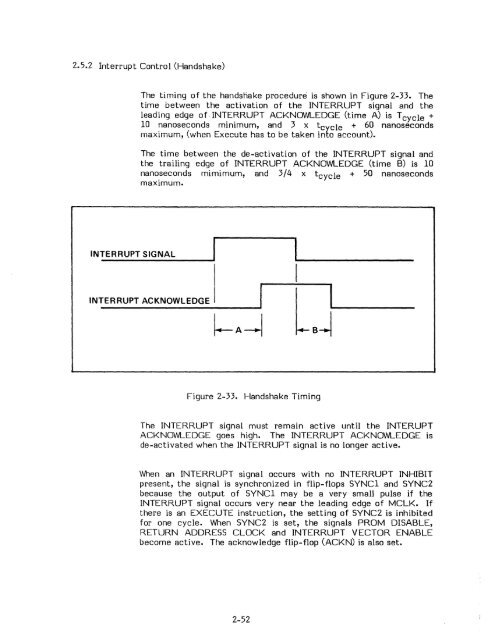8x300 design guide - Al Kossow's Bitsavers - Trailing-Edge
8x300 design guide - Al Kossow's Bitsavers - Trailing-Edge
8x300 design guide - Al Kossow's Bitsavers - Trailing-Edge
Create successful ePaper yourself
Turn your PDF publications into a flip-book with our unique Google optimized e-Paper software.
2.5.2 Interrupt Control (Handshake)<br />
The timing of the handshake procedure is shown in Figure 2-33. The<br />
time between the activation of the INTERRUPT signal and the<br />
leading edge of -INTERRUPT ACKNOWLEDGE (time A) is T cycle +<br />
10 nanoseconds minimum, and 3 x tc cle + 60 nanoseconds<br />
maximum, (when Execute has to be taken inro account).<br />
The time between the de-activation of the INTERRUPT signal and<br />
the trailing edge of INTERRUPT ACKNOWLEDGE (time B) is 10<br />
nanoseconds mimimum, and 3/4 x tcycle + 50 nanoseconds<br />
maximum.<br />
INTERRUPT SIGNAL<br />
INTERRUPT ACKNOWLEDGE<br />
Figure 2-33. Handshake Timing<br />
The INTERRUPT signal must remain active until the INTERUPT<br />
ACKNOWLEDGE goes high. The INTERRUPT ACKNOWLEDGE is<br />
de-activated when the INTERRUPT signal is no longer active.<br />
\Nhen an INTERRUPT signal occurs with no INTERRUPT INHIBIT<br />
present, the signal is synchronized in flip-flops SYNC 1 and SYNC2<br />
because the output of SYNC1 may be a very small pulse if the<br />
INTERRUPT signal occurs very near the leading edge of MCLK. If<br />
there is an EXECUTE instruction, the setting of SYNC2 is inhibited<br />
for one cycle. When SYNC2 is set, the signals PROM DISABLE,<br />
RETURN ADDRESS CLOCK and INTERRUPT VECTOR ENABLE<br />
become active. The acknowledge flip-flop (ACKN) is also set.<br />
2-52

















